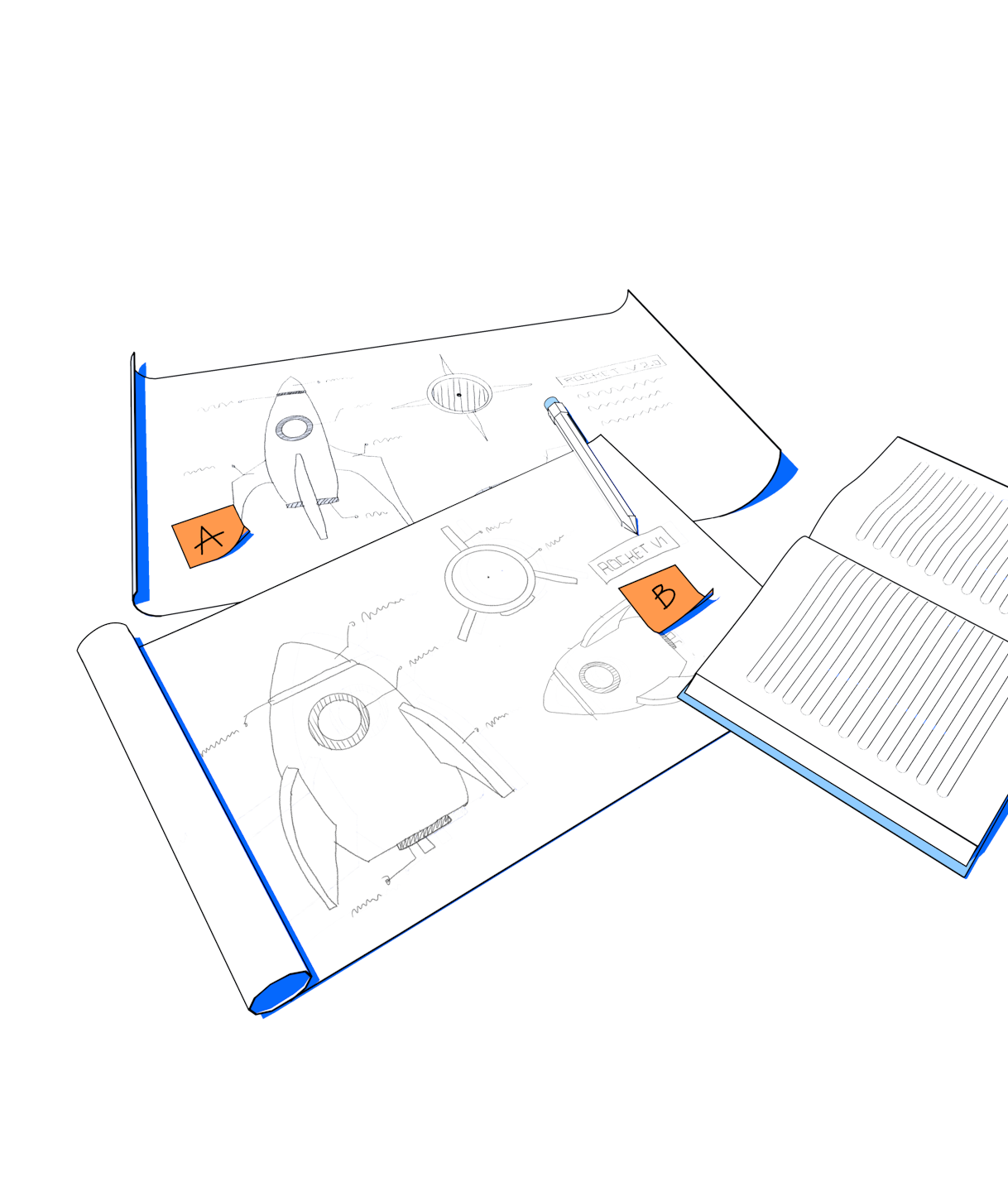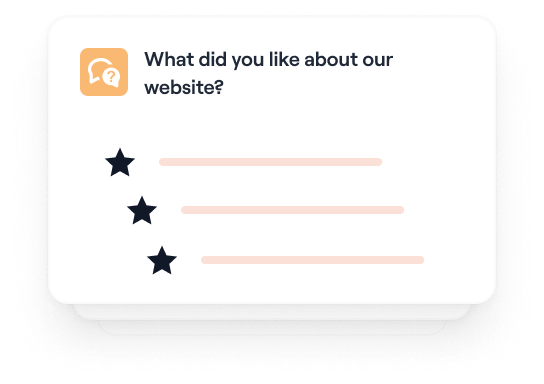To be successful and competitive in the market, your products should resonate with your customers and satisfy their evolving needs and expectations. Product surveys are one of the most effective ways to connect with your audience and quickly measure how they feel about your product or service. But if you want to get accurate data you can act on, you’ll need to ask the right survey questions.
In this article, we'll cover what a product survey is, why it matters, and how to write a successful one. And to help you get started, we’ll share a list of 13 survey questions to ask as well as real-life examples of product surveys.
What is a product survey?
A product survey is a research tool designed to help companies understand what customers think about their products. They allow product teams to collect customer opinions quickly and make informed decisions at each stage of the product development process.
Before launching a new product or feature, running a product survey is a great way to identify users' wants and needs, validate key decisions, and get a clear sense of the direction to take. A company can also send a survey for existing products to measure customer satisfaction and look for opportunities to improve and innovate.
Benefits of product surveys
Getting product feedback from your audience is essential to creating products your customers will love, use regularly, and recommend to their friends. Here are the top three benefits of running a product survey.
Product surveys help us validate or invalidate our assumptions, find commonalities across our target audience, and understand what can be improved. They provide us with a constant feedback loop that allows us to iterate and constantly improve.

Adarsh Pratap Singh
Product Marketing Specialist at TravelPerk
1. Get user insights quickly and easily
A product survey is a fast and cost-effective way to reach out to your customers and gather regular insights into user behavior, needs, pain points, likes, and dislikes. Most survey tools, including Maze, allow you to easily create and customize product surveys, share them with your audience, and access results quickly.
2. Inform your decision-making
The data you collect can help you and your team make informed decisions and determine which ones add real value to your users. This is crucial to better plan and prioritize the product roadmap and improve the product based on customers’ expectations.
3. Improve user experience and satisfaction
Your product's success revolves around your customers and their experiences. Running a product survey can help you connect with your customers, gauge their satisfaction, and identify any changes in their needs and expectations. In this way, you can monitor your product performance and make tweaks or improvements as needed.
Types of product surveys
Now that you know what a product survey is and how you can use it to benefit your product development strategy, here are a few of the most popular types of surveys you can choose from.
Idea validation surveys
Having a great idea is just the first step in building a new product or feature. How do you know if customers will actually use your solution? Are you solving a real problem for the user? Sending an idea validation survey to your target audience can help you answer these questions and get user feedback about the validity of your idea.
Concept testing surveys
Imagine you have identified a problem you want to solve. A concept testing survey is one of the easiest and quickest ways to validate potential solutions with users before investing time and resources into building them. Ask users how they feel about your concept and which aspects matter the most to them. This will allow you to understand which ideas are worth pursuing and focus your efforts in the right direction.
Customer satisfaction surveys
Customer satisfaction surveys are designed to help you understand if your customers are happy and satisfied with your product or service. Some of the most common metrics to measure the success of your product are Customer Satisfaction Score (CSAT) and Net Promoter Score (NPS).
Product feedback surveys
A product feedback survey is a powerful tool for gaining insights into how users experience your products. To achieve success and deliver great user experiences, you need to know what aspects of the product are performing well and which ones require attention. By empathizing with your customers and understanding their issues, preferences, and opinions, you can inform product improvements and gain a competitive advantage.
How to write a successful feedback survey
We went over the types of surveys that you might conduct. Now, let's look at how to build a survey step by step.
While every survey will differ depending on your goals, there are some steps and best practices that you can follow to get started.
1. Set a goal for your survey
Setting goals and objectives is the first step in writing a successful survey. Establish whom you will survey, what you want to learn, and how to use the results. Goals narrow your focus and make it easier to come up with the right survey questions you’d like to ask your audience.
2. Ask specific questions
To keep customers engaged throughout your survey, only include questions that serve your survey goal. Don’t ask for information you’re not going to use—keep your survey focused on the key topic. Your respondents' time is precious, so don't waste it. The shorter and to the point your survey is, the more likely people are to take it.
Also, make your question focused on one topic to get the most accurate answers. Trying to cover two separate subjects in one question may confuse the participants and lead to unfocused data.
3. Use simple language
Your survey should be simple and easy to understand. If your questions are confusing, participants may provide inaccurate survey responses or, worse still, not complete the survey. So, make sure you use the language that your target audience would use and avoid complex words, technical terms, and lengthy sentences.
4. Don’t use leading words
One of the essential rules for writing a good feedback survey is to avoid asking biased or leading questions that could influence the participants' answers and compromise the results. For instance, instead of asking, "How wonderful was your experience with our product?" ask, "How would you rate your experience with our product?" The data you collect will be more accurate and helpful.
Tip ✨
Check out our survey design guide written by Melanie Buset, User Researcher at Spotify, to learn more about how to structure your survey.
What to include in a feedback survey
Survey design plays a crucial role in determining how people will answer your questions and the overall quality of your data. Below, we’ll review some of the essential elements and types of questions you can include in your product survey:
- Introduction: The introduction is the first thing people will see when they start completing your survey. This is your chance to make a good first impression, explain the purpose of your survey, and set expectations.
- Multiple choice questions: Multiple choice questions ask participants to select one option or more from a list of responses. They are quick and easy for customers to complete and give you structured survey responses that are easier to analyze.
- Open-ended questions: Open-ended questions allow people to answer in open text format and elaborate on their responses. Answers to these questions are not limited to pre-set options, and users can give you their opinions in their own words.
- Opinion scales: In an opinion scale question, participants are presented with a series of statements and then asked to rate their opinion using a scale with opposite extremities. These questions are great to measure satisfaction, happiness, discomfort, and more.
- Yes/No questions: Yes/No questions allow you to ask participants a closed-ended question where the answer is either “yes” or “no”. They are a good way to segment your respondents. For example, you might want to separate the people who used your product from those who didn't and ask different follow-up questions accordingly.
- Thank you note: Adding a thank you note at the end of your survey is a great way to show your respondents that you appreciate their time and improve their survey experience. You can also offer participants a gift certificate as a thank you for their time.
Adarsh Pratap Singh, Product Marketing Specialist at TravelPerk, recommends using different survey questions to get quantitative and qualitative data. It’s also important to tell the respondents how long it will take to answer the survey.
Examples of good product feedback questions
Good product feedback questions are ones that let you gather unbiased, accurate survey responses from your customers. They are concise, specific, and lead to actionable insights into your customers' thoughts, needs, and expectations.
In the following section, we’ll look at a list of good survey questions that you can ask your customers to get the information you need.
13 product survey questions to ask
If you’re wondering what questions to ask in your product survey, look no further. Here are 13 essential survey questions for you to pick and choose from. We hope you can take inspiration from these examples and adapt them to meet your goals and needs.
1. How often do you use the product?
This question tells you how frequently customers use your product and is usually presented as a multiple-choice selection. It's important to give people a frame of reference, and answers can include "daily," "weekly," "monthly," or "less than monthly." The goal is to understand how relevant the product is to your users. The answers you get can be a strong indicator of customer satisfaction and retention.
2. How was your experience with the product?
This is one of the most popular customer satisfaction survey questions. Ask participants to rate their overall experience on a scale from 1 to 10. Learn if your product delivers a satisfactory user experience or if you need to conduct more research to identify what you need to improve.
3. Which features do you use the most?
This survey question lets you know which features are the most important and valuable to your customers. Learn how users interact with your product and what they truly need. Who knows—you might discover that a simple feature that you considered secondary is a must-have for many customers.
4. What essential features are we missing?
Understanding what your customers need is vital to build the right product and improve their retention. This question will help you realize what features are worth including in your product roadmap to keep up with your users’ expectations and stay relevant in the market.
5. Does the product help you achieve your goals?
Use this yes/no question to make sure your product does what it’s meant to do. You will need to follow up with customers who answer "no" to understand the reasons for their choice and identify any weaknesses in your product.
6. How likely are you to recommend the product to a friend or colleague?
We all know that word-of-mouth is a great way to market your product. Ask customers to rate how likely they are to recommend your product on a scale from 1 to 10. The results will allow you to calculate your Net Promoter Score (NPS)—a key indicator of customer satisfaction.
7. Which of the following words would you use to describe our product?
Invite users to describe your product to see how well you communicate your value proposition and product vision. The answers will help you understand if your messaging claims reflect your brand values and resonate with your target audience. You can present this question as a multiple-choice selection or as an open-ended question.
8. How would you feel if you could no longer use the product?
A simple yet effective way to measure product-market fit is the Sean Ellis test, also known as The 40% Test. Ask your users, “How would you feel if you could no longer use the product?” and let participants answer with one of these multiple-choice answers: "Very Disappointed," "Somewhat disappointed," "Not disappointed." If over 40% of your customers say they would be "very disappointed," you've achieved product-market fit.
9. If the product were no longer available, what would you use instead?
This survey question will help you identify your top competitors in the market. You can research the products mentioned by your customers to assess their strengths and weaknesses and identify opportunities to distinguish your product from its direct competitors.
10. How easy is our product to use?
This question allows you to investigate the usability of your product. It is often used in Customer Effort Score (CES) and System Usability Scale (SUS) surveys. Ask participants to rate how easy it is to use your product on a scale from “very easy” to “very difficult.” If your customers think it’s not very easy, consider including a follow-up question to narrow down the reasons for their choice.
For more details, check out our guide on how to ask effective usability testing questions.
11. How would you rate the value for money of the product?
Asking how the value of your product matches your prices can yield valuable information about what customers think about your current pricing. The feedback can help you determine if your offering is considered too expensive or too cheap.
12. What's the one thing we could do to make the product better?
Even if customers are happy with your product or service, there’s always room for improvement. Ask respondents for honest feedback and suggestions on what you could do better. The survey results will help you create better experiences for your users and turn them into loyal customers.
13. Any further thoughts or feedback you'd like to note?
It's always good to give your customers a chance to offer additional feedback at the end of the survey. Answers to this question can give you new insights or suggestions you hadn't considered.
Product survey templates
Want to see what a product survey actually looks like? Get inspired by these product survey templates from Maze and learn how we bring the user's voice into our decision-making.
Feature satisfaction survey template
Our product team uses Maze Templates to collect actionable insights and create better user experiences. This feature satisfaction survey helps us understand how users feel about our new features, measure their experience, and identify possible problems that we need to tackle.
These are the survey questions that we ask:
- On a scale from 1 to 10, how satisfied are you with the feature?
- Did you run into any problems with the feature?
- Will you continue using the feature?
- Do you have any thoughts or feedback on the feature?
Gather feedback from your users with our Get first impressions on new features template.
Live website feedback survey template
At Maze, we rely on this product survey template to capture user opinions on live web pages. Whether it’s design, copy, or the overall experience, we can collect actionable feedback that allows us to improve our website and boost engagement and conversion.
Let’s have a look at the website survey questions:
- Firstly, what brought you here today? (To purchase a product/To learn about our products/Returning customer/Just browsing)
- Did you find what you needed? (Yes/No)
- Can you describe your first impression of our website in three words?
- What did you like about our website?
- On a scale from 1 to 10, how likely are you to return?
Final thoughts
When designing a good product survey, asking the right questions is the best way to ensure you get quality feedback from your customers. We hope these questions and templates serve as inspiration for your next product survey so you can get the information you need to build a successful product.
Frequently asked questions about product surveys
What is a product survey?
What is a product survey?
A product survey is a research tool used to measure how customers feel about a product. Generally, a product survey comprises a collection of open-ended and closed-ended questions that allow product teams to get accurate customer feedback and make informed product decisions.
How do you create a product survey?
How do you create a product survey?
The first step when creating a product survey is to identify why you want to run the survey and what you want to learn. Having a clear goal will help you determine which type of product survey you need and the right questions to ask. Keep your survey simple and include only relevant questions that are clear, specific, and unbiased.
What is a good feedback survey?
What is a good feedback survey?
A good feedback survey lets you collect actionable insights from your customers. Good feedback surveys are simple, easy to understand, and use the right combination of question types and length to keep respondents engaged and yield accurate results.
What's the difference between a product survey and a product feedback survey?
What's the difference between a product survey and a product feedback survey?
Product feedback surveys are one of the most common types of product surveys. While a product survey helps you understand how customers feel about your products in general, a product feedback survey focuses on the customer experience with your products.







